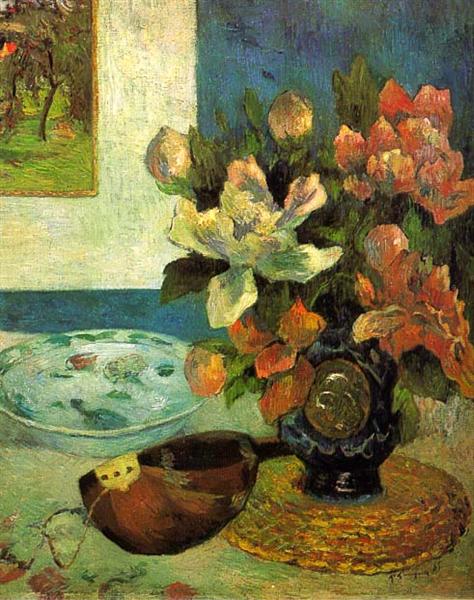Beschrijving
Paul Gauguin's Still Life with Mandolin, painted in 1885, is a piece that encapsulates the artist's transition to a more personal and symbolic artistic language, combining elements of still life with haunting echoes of the post-impressionist tradition. In this painting, Gauguin displays his mastery of composition, creating a visual harmony that invites the viewer to reflect on the relationship between everyday objects and the emotions they can evoke.
Looking at the work, we are immediately drawn to the mandolin, which occupies a central and dominant position. Its curvilinear form has an intrinsic beauty, and the warm tone of the wood glows under the soft light that seems to fall on the scene. This reminds us that Gauguin, although deeply influenced by Impressionism, began to distance himself from the mere representation of natural light, seeking instead a more internal and emotional approach. The mandolin, as a musical object, suggests harmony and rhythm, concepts that go beyond the visual and connect us to a deeper sense of human experience.
Gauguin’s chosen colour palette is equally significant, characterised by earthy tones that link warmth with sombreness. The ochres and yellows of the table contrast with the greens and blues that outline the background, creating a sense of depth and dynamism. This use of colour not only enriches the composition, but also invites a more subjective interpretation. The vibrant colours can evoke contrasting emotions of joy, melancholy, nostalgia, or even a deep serenity, reflecting the influence of the bohemian life that Gauguin experienced in Paris and in his later artistic quest in Tahiti.
The treatment of light in the painting is more than technical; it is almost symbolic. The lighting that bathes the mandolin suggests a kind of reverence towards the object, while the shadows that slide around the other elements suggest the complexity of existence and the passage of time. In this work, Gauguin moves away from simple representation, recovering a sense of the poetic, where the observer is also a participant in the visual narrative.
It is interesting to note that, although the painting does not feature human characters, the mandolin and the other objects highlight an intrinsic dialogue. Through the choice of the elements that make up the scene, Gauguin suggests the intimacy of everyday life, where the inanimate holds a story of its own in human existence. Still life thus becomes not only an aesthetic exercise, but a reflection on life and its fragility. This approach will resonate with Gauguin's later search for an increasingly symbolic and expressionist art.
"Still Life with Mandolin" is a work that invites us to enter the inner world of Paul Gauguin. It represents his own search for an art that would not only record the surface of the visible world, but would penetrate the deepest truths of being. In this sense, the painting is a clear precursor to the paths that Gauguin would follow in his career, from his imposing Tahitian portraits to his most abstract and emotional works. The mandolin, an everyday object, resonates in a universe of meanings, testifying to Gauguin's transformation as an artist who sought the essential behind the ephemeral.
KUADROS ©, a famous painting on your wall.
Hand-made oil painting reproductions, with the quality of professional artists and the distinctive seal of KUADROS ©.
Painting reproduction service with satisfaction guarantee. If you are not completely satisfied with the replica of your painting, we will refund 100% of your money.

